High Impact Tutoring Built By Math Experts
Personalized standards-aligned one-on-one math tutoring for schools and districts
In order to access this I need to be confident with:
Algebraic expressions Simplifying expressions Equivalent expressions PolynomialsFactoring
Here you will learn strategies for factoring algebraic expressions, including quadratics and polynomials. Factoring is a vital tool when simplifying expressions and solving quadratic equations.
Students first learn how to factor in the 6 th grade with their work in expressions and equations and expand that knowledge as they progress through algebra and beyond.
What is factoring?
Factoring is writing the algebraic expression as a product of its factors. It is the inverse process of multiplying algebraic expressions using the distributive property.
There are several strategies to factor algebraic expressions.
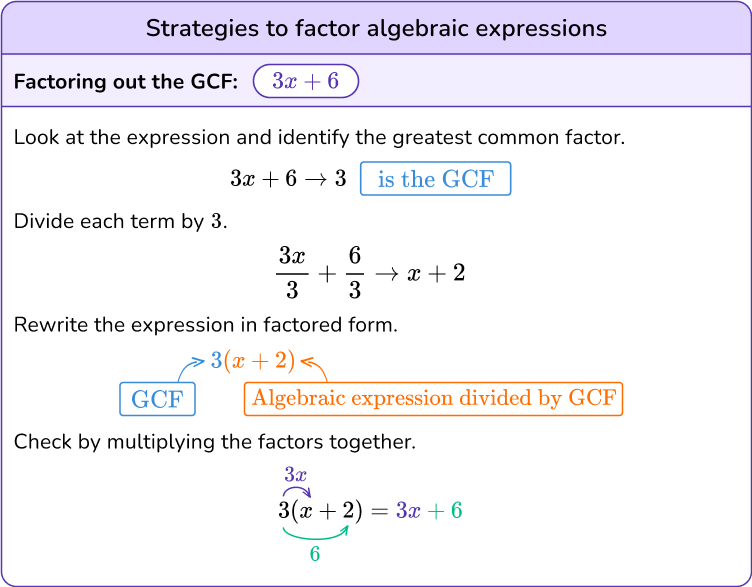
Step-by-step guide: Factoring out the GCF
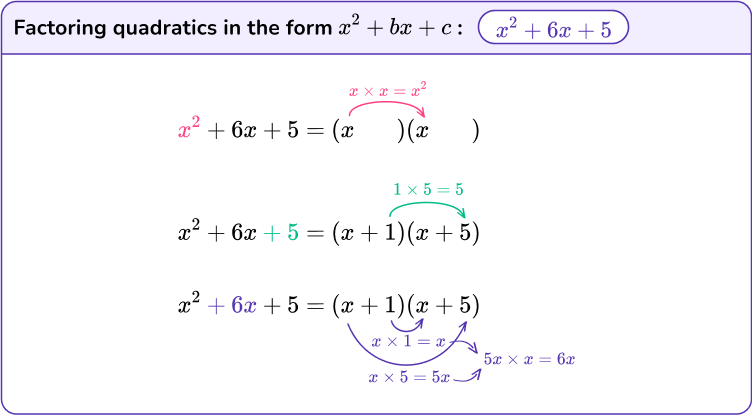
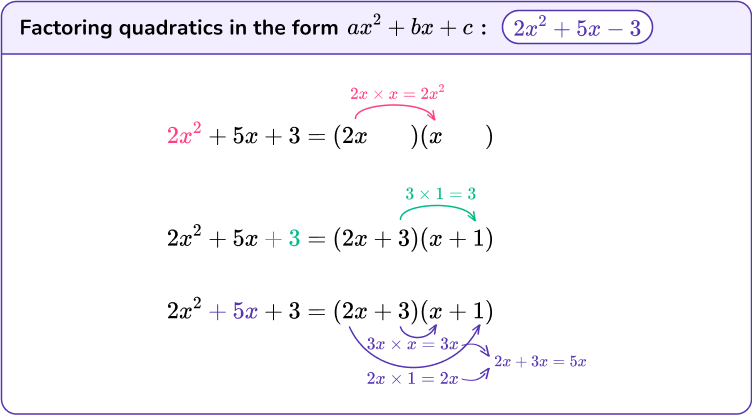
Step-by-step guide: How to factor quadratic equations
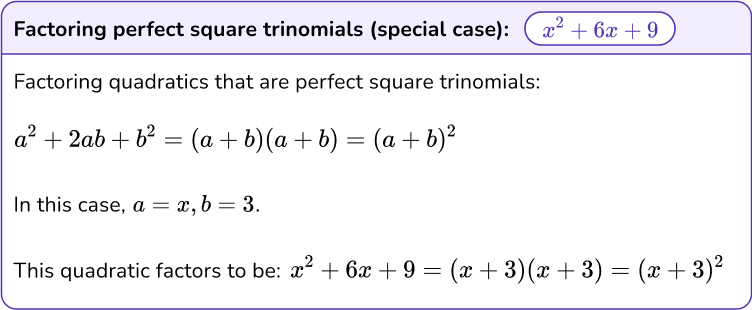
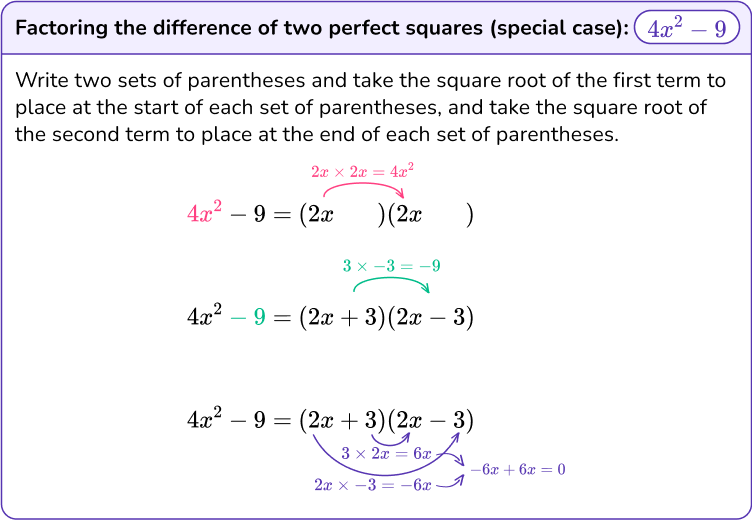
Step-by-step guide: Factoring the difference of two squares
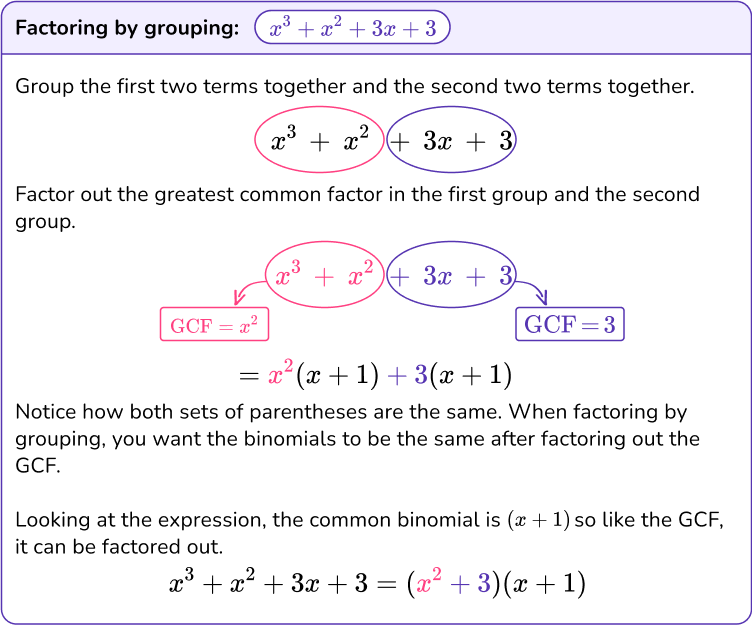
Step-by-step guide: Factor by grouping
What is factoring?
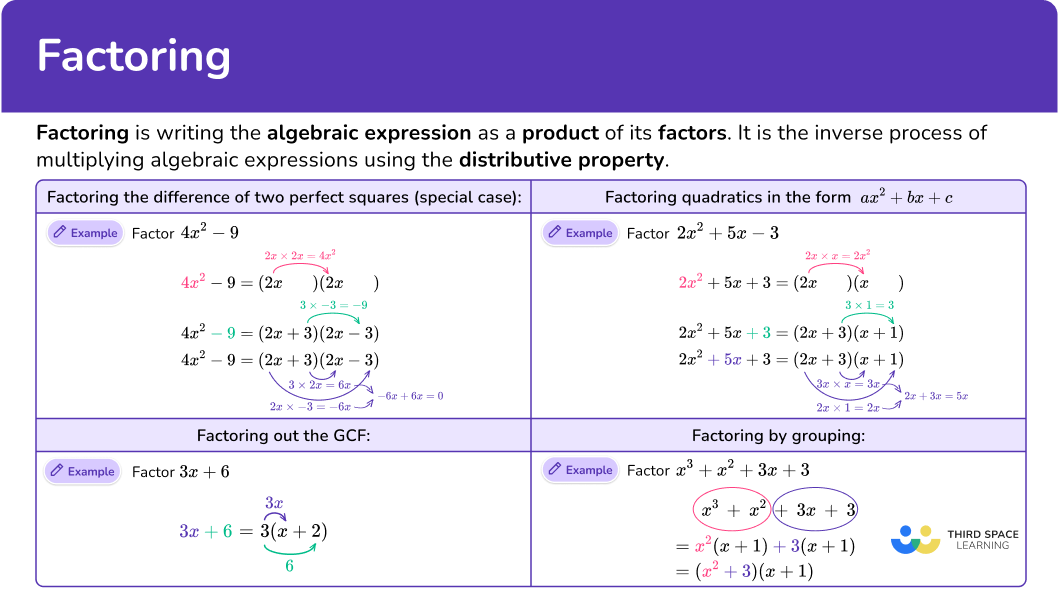
Common Core State Standards
How does this relate to 6 th grade math – high school math?
- Grade 6: Expressions and Equations (6.EE.A.3)
Apply the properties of operations to generate equivalent expressions. For example, apply the distributive property to the expression 3(2+x) to produce the equivalent expression 6+3x; apply the distributive property to the expression 24x+18y to produce the equivalent expression 6(4x+3y) .
- Grade 7: Expressions and Equations (7.EE.A.1)
Apply properties of operations as strategies to add, subtract, factor, and expand linear expressions with rational coefficients.
- High School Algebra: Seeing Structure in Equations (HSA-SSE.B.3a)
Factor a quadratic expression to reveal the zeros of the function it defines.
![[FREE] Algebra Worksheet (Grade 6 to 8)](https://thirdspacelearning.com/wp-content/uploads/2023/07/Algebra-check-for-understanding-quiz-listing-image-.png)
[FREE] Algebra Worksheet (Grade 6 to 8)
![[FREE] Algebra Worksheet (Grade 6 to 8)](https://thirdspacelearning.com/wp-content/uploads/2023/07/Algebra-check-for-understanding-quiz-listing-image-.png)
Use this quiz to check your grade 6 – grade 8 students’ understanding of algebra. 10+ questions with answers covering a range of 6th to 8th grade algebra topics to identify areas of strength and support!
DOWNLOAD FREE![[FREE] Algebra Worksheet (Grade 6 to 8)](https://thirdspacelearning.com/wp-content/uploads/2023/07/Algebra-check-for-understanding-quiz-listing-image-.png)
[FREE] Algebra Worksheet (Grade 6 to 8)
![[FREE] Algebra Worksheet (Grade 6 to 8)](https://thirdspacelearning.com/wp-content/uploads/2023/07/Algebra-check-for-understanding-quiz-listing-image-.png)
Use this quiz to check your grade 6 – grade 8 students’ understanding of algebra. 10+ questions with answers covering a range of 6th to 8th grade algebra topics to identify areas of strength and support!
DOWNLOAD FREEHow to factor algebraic expressions using the GCF
In order to factor out the GCF from algebraic expressions:
- Find the \textbf{GCF} of all terms in the expression and place it in front of parentheses.
- Divide each term in the expression by the \textbf{GCF}.
- Put the divided terms in the parentheses.
- Express the \textbf{GCF} and the other factors as a product.
Factoring GCF examples
Example 1: factor the algebraic expression
4x-20- Find the \textbf{GCF} of all terms in the expression and place it in front of parentheses.
The greatest common factor in the expression is 4.
4(\ \ \ \ \ \ \ \ \ \ )2Divide each term in the expression by the \textbf{GCF}.
Since 4 is the GCF,
4x \div 4=x -20 \div 4=-53Put the divided terms in the parentheses.
4(x-5)4Express the \textbf{GCF} and the other factors as a product.
4x-20=4(x-5)Example 2: factor the algebraic expression
2x^{2}-4xFind the \textbf{GCF} of all terms in the expression and place it in front of parentheses.
The GCF is 2x.
2x(\ \ \ \ \ \ \ \ \ \ )
Divide each term in the expression by the \textbf{GCF}.
Since 2x is the GCF,
2x^{2} \div {2x}=x
-4x \div {2x}=-2
Put the divided terms in the parentheses.
Express the \textbf{GCF} and the other factors as a product.
How to factor algebraic expressions with a equal to 1
In order to factor an algebraic expression in the form x^2+bx+c\text{:}
- Find two factors of the constant, \textbf{c} term, that sum to equal the coefficient of the \textbf{b} term.
- Write the quadratic in factored form with two sets of parentheses.
- Check your work and write the quadratic equation in factored form.
Example 3: factor the expression
x^{2}-3x-28Find two factors of the constant, \textbf{c} term, that sum to equal the coefficient of the \textbf{b} term.
The constant, c term, is -28 so one factor must be negative. The factors of -28 are:
\begin{array}{rl}1,&-28 \\\\ -1,&28 \\\\ 2,&-14 \\\\ -2,&14 \\\\ 4,&-7 \\\\ -4,&7 \end{array}
The coefficient of the b term is -3.
The two factors that multiply to -28 and add to -3 are -7 and 4.
\begin{aligned}-7\cdot4&=-28 \\\\
-7+4&=-3 \end{aligned}
Write the quadratic in factored form with two sets of parentheses.
The a term breaks up to be x\cdot{x} because x\cdot{x}=x^{2}
x^{2}-3x-28=(x-7)(x+4)
Check your work and write the quadratic equation in factored form.
You can check your work through distributive property.
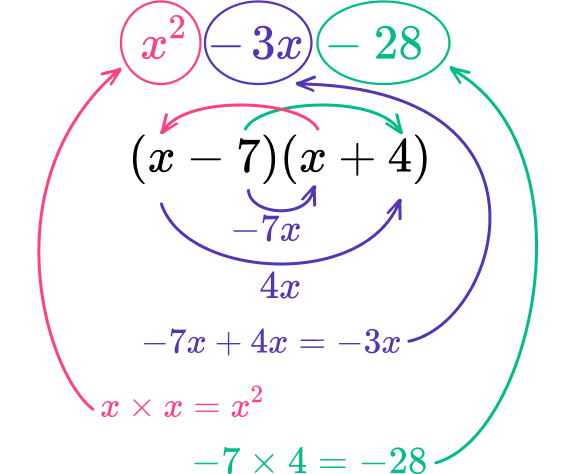
Example 4: factor the expression
x^{2}+7x+12Find two factors of the constant, \textbf{c} term, that sum to equal the coefficient of the \textbf{b} term.
The constant, c term, is + \; 12. As the b term is also positive, both factors are positive. The factors of 12 are:
\begin{array}{rl}1,&12 \\\\ 2,&6 \\\\ 3,&4 \end{array}
The coefficient of the b term is + \; 7.
The two factors that multiply to + \; 12 and add to 7 are 3 and 4.
\begin{aligned}
3\cdot4&=12 \\\\
3+4&=7 \end{aligned}
Write the quadratic in factored form with two sets of parentheses.
The a term breaks up to be x\cdot{x} because x\cdot{x}=x^{2}
x^{2}+7x+12=(x+3)(x+4)
Check your work and write the quadratic equation in factored form.
You can check your work through distributive property.
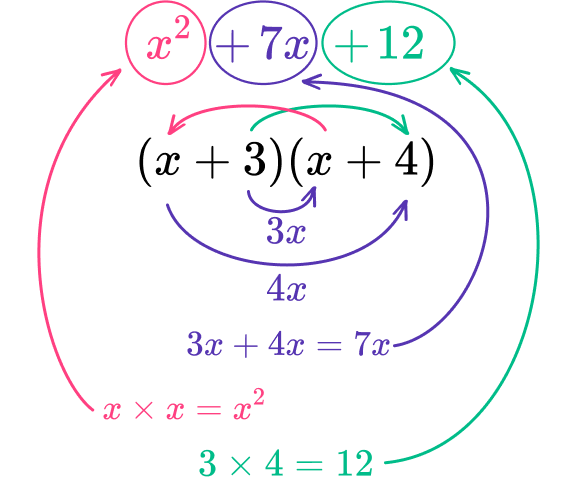
How to factor algebraic expressions with a not equal to 1
In order to factor an algebraic expression in the form ax^{2}+bx+c\text{:}
- Find the factors of \textbf{ac} that sum to equal the coefficient of the \textbf{b} term.
- Place the factors in the parentheses and check to make sure the product of the inside terms and outside terms sum to the \textbf{b} term.
- Write the quadratic equation in factored form.
Example 5: factor the expression
2x^{2}-11x+5Find the factors of \textbf{ac} that sum to equal the coefficient of the \textbf{b} term.
The value of ac is 2 \times 5=10. As the b term is negative and the c term is positive, both factors must be negative.
The factors of 10 are:
\begin{array}{cc}-1,&-10 \\\\ -2,&-5 \end{array}
The coefficient of the b term is -11. The factors of 10 that sum to -11 are -1 and -10.
Place the factors in the parentheses and check to make sure the product of the inside terms and outside terms sum to the \textbf{b} term.
The a term is 2x^{2} which you can factor into 2x and x.
So far, the factored quadratic looks like: (2x\ \ \ \ \ )(x\ \ \ \ \ \ )
As one of the parentheses contains 2x, the factor in the other bracket is multiplied by 2, therefore you must divide the factor by 2 in the other bracket.
As -10 is a negative multiple of 2, you can easily divide this by 2 to get -5 so you need to place the factor of -1 in the first pair of parentheses and -5 into the second pair of parentheses to get (2x-1)(x-5).
Now check the expansion.
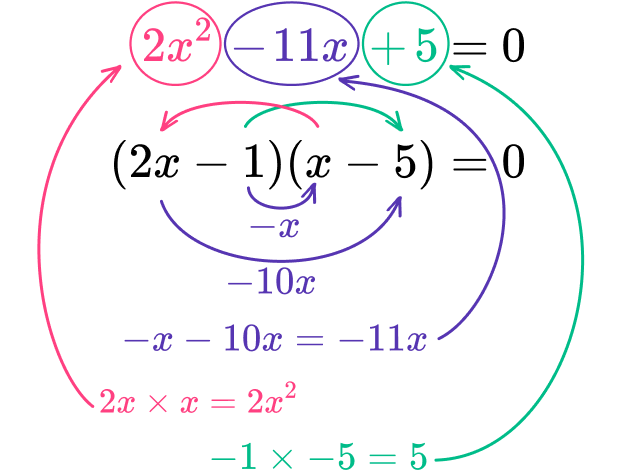
Each term is correct.
Write the quadratic equation in factored form.
Example 6: factor the expression
2x^{2}+5x+3Find the factors of \textbf{ac} that sum to equal the coefficient of the \textbf{b} term.
The value of ac is 2 \times 3=6. As the b term is positive and the c term is positive, both factors must be positive.
The factors of 6 are:
\begin{array}{cc}1,&6 \\\\ 2,&3 \end{array}
The coefficient of the b term is + \; 5. The factors of 6 that sum to 5 are 2 and 3.
Place the factors in the parentheses and check to make sure the product of the inside terms and outside terms sum to the \textbf{b} term.
The a term is 2x^{2} which you can factor into 2x and x.
So far, the factored quadratic looks like: (2x\ \ \ \ \ )(x\ \ \ \ \ \ )
As one of the parentheses contains 2x, the factor in the other bracket is multiplied by 2, therefore you must divide the factor by 2 in the other bracket.
As 2 is a multiple of 2, you can easily divide this by 2 to get 1 so you need to place the factor of 3 in the first pair of parentheses and 1 into the second pair of parentheses to get (2x+3)(x+1).
Now check the expansion.
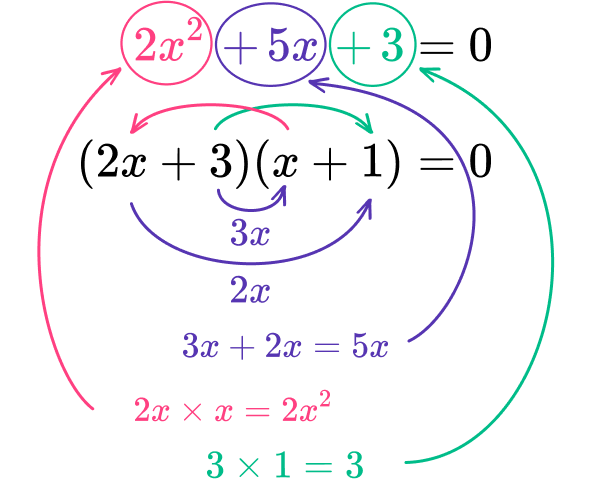
Each term is correct.
Write the quadratic equation in factored form.
How to factor algebraic expressions (difference of two squares)
In order to factor the difference of two squares.
- Write two sets of parentheses.
- Square root the first term and write it on the left hand side of both brackets
- Square root the last term and write it on the right hand side of both brackets.
Example 7: factor the expression
4x^{2}-25Write two sets of parentheses.
Square root the first term and write it on the left hand side of both brackets.
The first term is 4x^{2}. Square root this to get
\sqrt{4x^{2}}=2x
(2x\ \ \ \ \ \ )(2x\ \ \ \ \ \ )
Square root the last term and write the two values on the right hand side of each bracket.
The last term is 25. Square root this to get
\sqrt{25}=\pm5
(2x+5)(2x-5)
How to factor algebraic expressions by grouping
In order to factor by grouping:
- Group the first two terms together and the last two terms together.
- Factor out the \textbf{GCF} from each binomial.
- Factor out the common binomial.
Example 8: factor the expression
2x^{3}-10x^{2}+3x-15Group the first two terms together and the last two terms together.
Factor out the \textbf{GCF} from each binomial.
Factor out the common binomial.
Teaching tips for factoring
- Use visual tools such as algebra tiles or digital algebra tiles so students can connect the area model with arrays to factoring.
- Although worksheets have their place, having students work in collaborative groups to problem solve is essential to the math classroom.
Easy mistakes to make
- Using the wrong factors
For example, factoring x^{2}+5x+6, by using the incorrect factors of 6. \; (x+1)(x+6)≠ {x^{2}}+5x+6 as 1+6=7, not 5. Here, the correct factored form is (x+2)(x+3).
- Not factoring out the greatest common factor
For example, factoring 4x^{2}-16x to be 2(2x^{2}-8x). \; 2 is not the GCF of the expression, 4x is the GCF. So, the correct factored expression is 4x(x-4).
- Not finding the square root when factoring the difference of squares
For example, factoring 16x^{2}-4 to be (8x-2)(8x+2). The correct factored expression should be (4x-2)(4x+2) as \sqrt{16x^{2}}=4x.
Practice factoring questions
1. Factor the expression.
10-5y




The greatest common factor of 10 and 5 is 5. Divide both terms by 5 to get 10-5y=5(2-y).
2. Factor the expression.
20x^{2}-8x




The greatest common factor of 20x^{2} and 8x is 4x. Divide both terms by 4x to get 20x^{2}-8x=4x(5x-2).
3. Factor the expression.
x^{2}-x-6




The factors of -6 that sum to -1 are -3 and 2.
x^{2}-x-6=(x+2)(x-3)
4. Factor the expression.
3x^{2}-2x-5




For the quadratic, 3x^{2}-2x-5, the value of ac is 3\times{-5}=-15. The factors of -15 that have a sum of -2 are -5 and 3. The a term can be factored into 3x and x so the factored form is currently (3x\ \ \ \ \ )(x\ \ \ \ \ \ ).
As one of the parentheses contains 3x, the factor in the other bracket is multiplied by 3, therefore divide the factor by 3 in the other bracket.
As 3 is a multiple of 3, you can easily divide this by 3 to get 1 so -5 is in the first pair of parentheses and 1 is in the second pair to get (3x-5)(x+1).
5. Factor the expression.
x^{2}-36




The expression is the difference of two perfect squares. To factor this expression, take the square root of the first term and place it in the first position of each parenthesis.
x^{2}=36
\sqrt{x^{2}}=x
(x\ \ \ \ \ )(x\ \ \ \ \ )
Take the square root of the second term and place the values in the second position of each parenthesis.
\sqrt{36}=\pm6
(x+6)(x-6)
6. Fully factor the expression,
x^{3}-2x^{2}+4x-8




Group the first two terms and second two terms together.
(x^{3}-2x^{2}) (+4x-8)
The GCF of the first set is x^{2} and the GCF of the second set is positive 4.
x^{2}(x-2)+4(x-2)
Factor out the common binomial.
(x-2)(x^{2}+4)
Factoring FAQs
Yes, you can factor polynomial expressions with more than one variable. For example, xy-3y, factors to be y(x-3).
Yes, sometimes when factoring expressions completely, you might have to apply more than one strategy. For example, when factoring 3x^{2}-27, you first factor out the GCF. 3(x^{2}-9).
Then you factor the parenthesis by using the strategy of the difference of two perfect squares. \sqrt{x^{2}}=x and \sqrt{9}=\pm3. So, the expression completely factored is 3(x-3)(x+3).
Yes, there are strategies you will learn to factor the difference of cubes and the sum of cubes in Algebra 2.
No, the sum of two squares is considered to be prime which means it cannot be factored. Quadratic polynomials can be prime meaning the only factors it has is itself and 1, like prime numbers.
Applying strategies of factoring helps to make solving equations easier. It can also help when finding the x -intercepts of polynomial functions.
The leading coefficient of algebraic expressions can be fractions and they can be factored. For example, \cfrac{1}{2}x-\cfrac{3}{4} factors to be \cfrac{1}{2}\left(x-\cfrac{3}{2}\right).
The next lessons are
Still stuck?
At Third Space Learning, we specialize in helping teachers and school leaders to provide personalized math support for more of their students through high-quality, online one-on-one math tutoring delivered by subject experts.
Each week, our tutors support thousands of students who are at risk of not meeting their grade-level expectations, and help accelerate their progress and boost their confidence.

Find out how we can help your students achieve success with our math tutoring programs.
[FREE] Common Core Practice Tests (3rd to 8th Grade)
Prepare for math tests in your state with these 3rd Grade to 8th Grade practice assessments for Common Core and state equivalents.
Get your 6 multiple choice practice tests with detailed answers to support test prep, created by US math teachers for US math teachers!